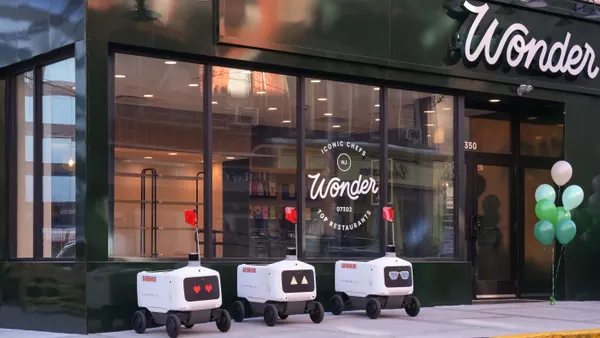Dive Brief:
- In an emergency order from San Francisco Mayor London Breed, the city is capping all food service delivery app fees at 15% an order until restaurants are able to offer dine-in service again, according to the San Francisco Examiner. Enforcement began Monday.
- This decision came after chefs and restaurant owners across the city complained about high delivery fees, up to 30% per order at times, which further compromised their businesses during the coronavirus crisis.
- This announcement comes at the same time DoorDash announced it would trim independent restaurants’ commission fees by 50%. However, San Francisco’s policy affects all restaurants and supersedes this policy, which only applies to restaurants with five or fewer locations.
Dive Insight:
In the announcement, Mayor Breed wrote: “Restaurants across San Francisco are struggling to stay open. In these tough financial circumstances, every dollar counts and can make the difference between a restaurant staying open, or shuttering. It can make the difference between staying afloat or needing to lay-off staff.”
However, restaurants’ struggles over high delivery commission fees long preceded the coronavirus pandemic. With average profit margins in the low-single digits, delivery commission fees averaging between 10% and 30% don’t leave much for restaurants at the end of an order.
This is the first legislation of this kind in the U.S., though other jurisdictions have entertained the idea, according to Eater S.F. In February, the New York City Council introduced a series of bills aimed at regulating the food delivery industry, including one proposal capping commissions at 10%.
Unsurprisingly, delivery companies have voiced their opposition to the San Francisco cap. In a statement, DoorDash called the policy “rushed” and “arbitrary”, adding that it doesn’t ensure that delivery drivers are paid fairly. Uber Eats told Restaurant Hospitality that regulating commissions would “force us to radically alter the way we do business.”
Grubhub told Restaurant Hospitality that its San Francisco-based partners have always been able to receive delivery fees for under 15%, but many choose to pay more for additional services and marketing support. Grubhub further suggested this cap will result in higher diner fees and decreased restaurant orders.
“Restaurant owners know what is best for their businesses and Grubhub remains committed to helping them every step of the way,” the company’s statement continued.
Therein lies a potential issue with these caps should they expand to other jurisdictions and/or continue beyond the pandemic. Does the policy negate the supply-and-demand-driven market? Will it force delivery companies to stop doing business with lower-cost restaurants? Perhaps.
Discussions about foodservice delivery regulations have been taking place for at least four years, so plenty of eyes will be watching how San Francisco’s policy goes for both the restaurants and the delivery companies. Considering that market’s size, any such regulation could perhaps be replicated elsewhere.
At the end of the day, the restaurant/delivery company relationship is symbiotic, so any such regulation has to work for both. But without restaurants, restaurant delivery companies cease to exist, so operators may continue to have some leverage to drive changes well beyond the pandemic.










